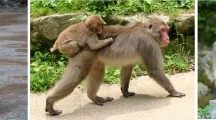Abstract
The occurrence of male-care behaviour directed from juvenile and adult males to infants was studied in a free-ranging troop of Stumptail macaques. The study period lasted two months comprising about 140 hours of recorded observations.
Infants were a focal subgroup and their interactions with older males were recorded. The following variables were examined in relationship to the sending and receiving of male-care: the infant (its age, sex, and dominance rank), older males (their age and dominance rank), and genetic ties.
Infants I received more male-care than infants II and differences in the type of male-care received by infants I and II were found. Male infants received more male-care than female infants and sex differences in the type of care received were evident. No relationship was found between the infant’s dominance rank and the amount of male-care received. A substantial amount of male-care behaviour was sent to genetic kin.
Two-three year olds displayed more male care than yearlings. Juveniles as a class displayed more male-care than adults. A positive association was found between the juveniles’ dominance rank and the sending of male-care. However, among the adults, the subordinate male displayed more care behaviour than the alpha male. The presence or absence of the mother was found to influence the older males’ interest in the infant. The results are discussed and compared with data available on other primate species.
Similar content being viewed by others
References
Alexander, B. K., 1970. Parental behavior of adult male Japanese monkeys.Behaviour, 36: 270–285.
Altmann, J., 1974. Observational study of behavior: Sampling methods.Behaviour, 49: 227–265.
Bernstein, I. S., 1975. Activity profiles in a Gelada monkey group.Folia primat., 23: 50–71.
Bertrand, M., 1969.The Behavioral Repertoire of the Stumptail Macaque. Bibliotheca Primatologica, No. 11, S. Karger, Basel.
Brandt, E. M., R. Irons, &G. Mitchell, 1970. Paternalistic behavior in four species of macaques.Brain, Behavior & Evolution, 3: 415–420.
Burton, F. D., 1972. The integration of biology and behavior in the socialization ofMacaca sylvana of Gibraltar. In:Primate Socialization,F. E. Poirier (ed.), Random House, New York, pp. 29–62.
Chevalier-Skolnikoff, S., 1975.The Ontogeny of Communication in the Stumptail Macaque (Macaca arctoides). Contribution to Primatology, No. 2, S. Karger, Basel.
Deag, J. M. &J. H. Crook, 1971. Social behaviour and “agonistic buffering” in the wild barbary macaque,Macaca sylvana L.Folia primat., 15: 183–200.
DeVore, I. &K. R. L. Hall, 1965. Baboon social behavior. In:Primate Behavior: Field Studies of Monkeys and Apes,I. DeVore (ed.), Holt, Rinehart, & Winston, New York, pp. 53–110.
Estrada, A., 1976. A ten month field study on the ontogeny of social relations in a free-ranging group of stumptail macaques (Macaca arctoides). Ph. D. Thesis, Rutgers University.
————, 1976a. Birth and breeding cyclicity in an out-door living stumptail macaque (Macaca arctoides) group.Primates, 17: 225–231.
———— & ————, 1976b. Establishment of a free-ranging colony of stumptail macaques (Macaca arctoides): Relations to the ecology I.Primates, 17: 337–355.
Gouzoules, H., 1975. Maternal rank and early social interactions of infant stumptail macaques,Macaca arctoides.Primates, 16: 405–418.
Hendy-Neely, H. &R. J. Rhine, 1977. Social development of stumptail macaques (Macaca arctoides): Momentary touching and other interactions with adult males during the infants’ first 60 days of life.Primates, 18: 589–600.
Itani, J., 1963. Paternal care in the wild Japanese monkey,Macaca fuscata. In:Primate Social Behavior,C. H. Southwick (ed.), Van Nostrand, New York, pp. 91–97.
Kaufmann, J. H., 1967. Social relations of adult males in a free-ranging band of rhesus monkeys. In:Social Communication Among Primates,S. A. Altmann (ed.), Univ. of Chicago Press, pp. 73–98.
Koford, C. B., 1963. Rank of mothers and sons in bands of rhesus monkeys.Science, 141: 356–357.
Kummer, H., 1967. Tripartite relations in hamadryas baboons. In:Social Communication Among Primates,S. A. Altmann (ed.), Univ. of Chicago Press, pp. 63–91.
Lahiri, R. K. &C. H. Southwick, 1966. Parental care inMacaca sylvana.Folia primat., 4: 257–264.
Lancaster, J. R., 1972. Play-mothering: The relations between juvenile females and young infants among free-ranging vervet monkeys. In:Primate Socialization,F. E. Poirier (ed.), Random House, New York, pp. 3–104.
Mitchell, G., 1969. Paternalistic behavior in primates.Psychol. Bull., 71: 399–417.
————, 1972. Paternal behavior in primates. In:Primate Socialization,F. E. Poirier (ed.), Random House, New York, pp. 173–206.
Ransom, T. W. &B. S. Ransom, 1971. Adult male-infant relations among baboons (Papio anubis).Folia primat., 16: 179–195.
————, 1972. Early social development of feral baboons. In:Primate Socialization,F. E. Poirier (ed.), Random House, New York, pp. 105–144.
Redican, W. K. &G. Mitchell, 1974. Play between adult male and infant rhesus monkeys.Amer. Zool., 14: 295–302.
Rhine, R., 1973. Variation and consistency in the social behavior of two groups of stumptail macaques (Macaca arctoides).Primates, 14: 21–35.
Rowell, T. E., 1968. The effect of temporary separation from their groups on the mother-infant relationship of baboons.Folia primat., 9: 114–122.
Sade, D. S., 1965. Some aspects of parent-offspring and sibling relations in a group of rhesus monkeys, with a discussion of grooming.Amer. J. Phys. Anthrop., 23: 1–17.
————, 1967. Determinants of dominance in a group of free-ranging rhesus. In:Social Communication Among Primates,S. A. Altmann (ed.), Univ. of Chicago Press, Chicago.
Spencer-Booth, Y., 1968. The behavior of group companions toward rhesus monkeys infants.Anim. Behav., 16: 541–557.
van Lawick-Goodall, J., 1967. Mother-offspring relationships in free-ranging chimpanzees. In:Primate Ethology,D. Morris (ed.), Aldine, Chicago, pp. 365–446.
————, 1968. The behavior of free-living chimpanzees in the Gombe Stream Reserve.Animal Behavior Monograph Series, 1: 161–311.
Welkowitz, I., R. Ewen, &I. Cohen, 1971.Introductory Statistics for the Behavioral Sciences. Academic Press, New York.
Yamada, M., 1963. A study of blood relationships in the natural society of Japanese monkey.Primates, 4: 43–65.
Author information
Authors and Affiliations
Additional information
Supported by grants from the Behavioral Science Foundation (U.S.) and by the Mexican Institute of Anthropology.
About this article
Cite this article
Estrada, A., Sandoval, J.M. Social relations in a free-ranging troop of stumptail macaques (Macaca arctoides): Male-care behaviour I. Primates 18, 793–813 (1977). https://doi.org/10.1007/BF02382931
Received:
Accepted:
Issue Date:
DOI: https://doi.org/10.1007/BF02382931




